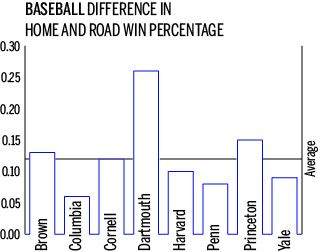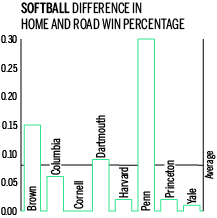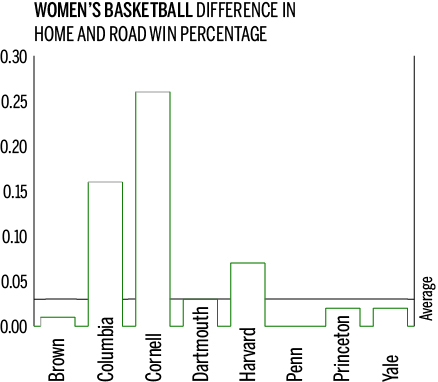One of the quirks of Ivy League scheduling is the employment of a travel-partner system that allows schools to play multiple opponents in one weekend. In Ivy League play, pairs of schools are matched up based on proximity and either travel together to play another pair of travel partners or host a pair of travel partners in any given weekend.
Though proximity between two schools is the basis for assigning travel partners in efforts to minimize total travel around the Ivy League, the geographic distance between schools is far from equal. This distance leads many members of the Yale athletics community to believe that Cornell, the furthest school from any one of the other Ivy League schools, has the best home-field advantage in the Ancient Eight. We at the Yale Undergraduate Sports Analytics Group wanted to see if the stats backed up Cornell’s alleged edge.
To do this, we calculated Ivy League teams’ win rates at home and subtracted them by their win rates on the road, using data from IvyLeague.com. In theory, this controls for a school being overall very strong or very weak, since we are only looking at the difference between home and road performance. We only looked at Ivy League play since teams only use the travel-partner system for conference weekends.
The distance between Cornell and Princeton is 222 miles, taking a travel time of approximately four hours by car. Compared to the 103-mile journey between Yale and Brown or the 130-mile trip between Harvard and Dartmouth, the hike to Ithaca is almost twice the distance and usually takes over twice as long, meaning teams first playing at Princeton or Columbia will often arrive at Cornell past midnight before their games the next day.
“The away games to Cornell are definitely something we have to mentally prepare for,” said Kumar Nambiar ’19, a pitcher for the Yale baseball team. “The bus ride to Ithaca is a lot longer than any other one we take and it is definitely harder to get enough rest.”

Looking at baseball, we found one team with a home-field advantage that towers over the others: Dartmouth. Ever since Red Rolfe Field in Hanover was renovated in 2009 — which is when our data begins — the Big Green has enjoyed a high amount of success at home.
We see a similar result with softball, this time with Penn holding a distinct advantage. Across the five sports we tracked, the Quaker softball team’s 30 percent difference between home and road win percentages is the largest margin we see. Conversely, Brown men’s basketball has a 7 percent lower win mark at home than on the road since 2009, the largest home disadvantage we found in our data.
Out of baseball, softball, men’s and women’s basketball and volleyball, we find that Cornell holds a significant home-court advantage in only women’s basketball, refuting our hypothesis that the Big Red’s seclusion in Ithaca provides a unique advantage. In fact, the only three statistically significant home-field advantages we found using a t-test at a 95 percent confidence level are Dartmouth baseball, Penn softball and Cornell women’s basketball. Even though Columbia women’s basketball has a much larger advantage than other women’s basketball teams, its 16 percent advantage is still not significant, given the average home-court advantage in the five sports of 11.67 percent.

Of course, our method of estimating home-field advantage is far from perfect.
For starters, our measure looks at home-field advantage overall. In theory, this not only includes travel distance, but also accounts for factors such as crowd noise or advantages at a specific stadium or field, when we really only want to examine the isolated effect of travel distance.
In baseball, for example, every field has different measurements and teams may tailor their personnel to their home field. Columbia’s Robertson Field measures much smaller than other fields, which makes it easier to hit home runs. Thus, during recruiting, the Lions may focus more heavily on players who can hit deep fly balls, a strategy that may not be suited for frequent play at other fields.
Another distortion that may arise is that even though we attempt to control for the overall strength of a team, our data set is not large enough to see past a team’s recent success. An eight-year stretch is too short to look at every team during both their strong and weak years. Since Red Rolfe Field’s renovation, the Big Green had never dropped multiple games in a four-game series at home until last year when they lost three out of four to the Bulldogs.
That means since the beginning our data in 2009, Dartmouth went either 3–1 or 4–0 in its home series every year, which would be a significant boost to its home win percentage. Perhaps Dartmouth really does have an incredible home-field advantage, but going 1–3 against Yale last year may indicate a regression to the mean and an overstated home-field advantage in our measurement.
Still, if the Cornell travel-partner advantage truly existed, we would expect to see the Big Red and its travel partner have even a slightly larger gap between its home and away win percentages when compared to other schools. Playing on the road is always daunting, but it looks like playing in Ithaca is just as hard as playing in Providence or Cambridge. Hopefully, knowing this helps our athletes sleep a little easier when they take their next long trip up north.







